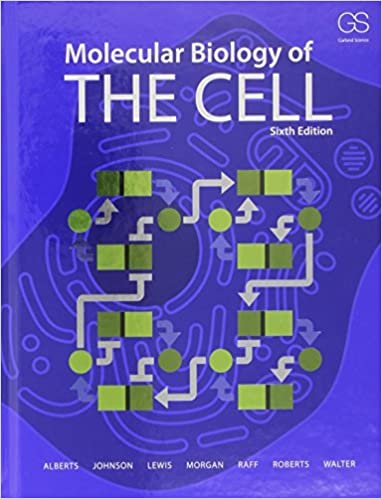
Molecular Biology Of The Cell 6th Edition by Bruce Alberts, Alexander Johnson, Julian Lewis, David Morgan, Martin Raff, Keith Roberts, Peter Walter
Edition 6ISBN: 978-0815345244
Molecular Biology Of The Cell 6th Edition by Bruce Alberts, Alexander Johnson, Julian Lewis, David Morgan, Martin Raff, Keith Roberts, Peter Walter
Edition 6ISBN: 978-0815345244 Exercise 9
For fusion of a vesicle with its target membrane to occur, the membranes have to be brought to within 1.5 nm so that the two bilayers can join (Figure Q13-1). Assum- ing that the relevant portions of the two membranes at the fusion site are circular regions 1.5 nm in diameter, calcu- late the number of water molecules that would remain between the membranes. (Water is 55.5 M and the volume of a cylinder is  Given that an average phospholipid
Given that an average phospholipid  occupies a membrane surface area of
occupies a membrane surface area of  how many phospholipids would be present in each of the opposing monolayers at the fusion site? Are there sufficient water molecules to bind to the hydrophilic head groups of this number of phospholipids? (It is estimated that 10-12 water molecules are normally associated with each phospho- lipid head group at the exposed surface of a membrane.)
how many phospholipids would be present in each of the opposing monolayers at the fusion site? Are there sufficient water molecules to bind to the hydrophilic head groups of this number of phospholipids? (It is estimated that 10-12 water molecules are normally associated with each phospho- lipid head group at the exposed surface of a membrane.)
 Given that an average phospholipid
Given that an average phospholipid  occupies a membrane surface area of
occupies a membrane surface area of  how many phospholipids would be present in each of the opposing monolayers at the fusion site? Are there sufficient water molecules to bind to the hydrophilic head groups of this number of phospholipids? (It is estimated that 10-12 water molecules are normally associated with each phospho- lipid head group at the exposed surface of a membrane.)
how many phospholipids would be present in each of the opposing monolayers at the fusion site? Are there sufficient water molecules to bind to the hydrophilic head groups of this number of phospholipids? (It is estimated that 10-12 water molecules are normally associated with each phospho- lipid head group at the exposed surface of a membrane.)Explanation
In order to have maximum alkaline phosph...
Molecular Biology Of The Cell 6th Edition by Bruce Alberts, Alexander Johnson, Julian Lewis, David Morgan, Martin Raff, Keith Roberts, Peter Walter
Why don’t you like this exercise?
Other Minimum 8 character and maximum 255 character
Character 255


